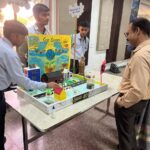The field of design is dynamic, always changing and taking on new forms. Fundamentally, design is, by nature, futuristic.
New technological advancements are continually changing the fast-paced lifestyle of today’s people, and incorporating “tech” into design is essential to producing immersive, impactful, and transformative experiences.
The combination of technology and design is giving designers a chance to go beyond previous limits. It takes a deep understanding of developing technology, changing customer behaviour, and cultural developments to effectively design for the future.
The Changing Dynamics of Industry
One of the key themes influencing the direction of fashion design, from fast fashion to haute couture, is sustainability, which is now acting as a catalyst for creativity and innovation.
Renovating the wearable future:
- Sustainability is a broad phrase that encompasses all goods, procedures, actions, and parties involved in the pursuit of carbon-neutral sectors founded on ecological integrity, social justice, equality, and welfare.
- In order to contribute to a future where people care more about the environment, designers are placing a greater emphasis on eco-friendly materials, energy-efficient production techniques, and circular design principles that reduce waste and increase longevity.
- The need for inclusive design is growing as society grows more varied, and designers are being pushed to create collections that honour people of various ages, genders, sizes, shapes, abilities, and backgrounds.
The lines separating the actual and digital worlds have become more blurred with the advent of technologies like social networking, e-commerce, virtual reality, augmented reality, and artificial intelligence. The use of technology to create personalised and interactive experiences has expanded the possibilities available to designers, ranging from virtual fashion presentations to 3-D printing. Virtual reality platforms and online design tools can improve alliances and collaborations by enabling designers to collaborate remotely with manufacturers and clients and team up globally with other designers.
Overcoming Industry Obstacles: The Way Ahead
A designer’s responsibility:
- Designers must address a wide range of issues that call for creative answers in addition to these trends. In a market driven by customer demand, designers must strike a balance between practicality and innovation.
- A thorough grasp of consumer preferences and market dynamics can help achieve this. Designers may effortlessly combine form and functionality if they are open to making changes to their designs in response to user feedback and have a thorough understanding of user wants and behaviours.
- Transparency and accountability are receiving more attention in the fashion sector these days. Consumer pressure to ensure ethical sourcing and production procedures is now exerting pressure on the industry due to increased scrutiny of labour conditions and supply chain practices.
In addition, obstacles, including cultural disparities, complicated regulations, and geopolitical dangers, must be faced by designers due to the worldwide scope of the fashion industry. To ensure that their designs are embraced by a variety of audiences worldwide, designers must navigate these challenges with tact and cultural awareness.
Take Control of the Future
Despite the difficulties, the fashion business has a bright future ahead of it. Innovative designers are embracing new trends and utilising cutting-edge technologies to improve our lives and influence the environment. For those that are prepared to embrace change and push the envelope of creativity, the opportunities are endless—whether it’s leading the way in ecological practices, promoting inclusion, or reinventing the shopping experience.
To sum up, creating for the future entails being inclusive and putting the user first. We are now entering a new era where it can be difficult to keep up with technology while maintaining a human touch. Beyond the traditionally defined scope, it is imperative that we consider not just the “now,” but also the relationship and shared duty with regard to the immediate surroundings, neighbourhood, city, and global community.
(This article is authored by Neha Dubey, Assistant Professor, JD School of Design, Bangalore.)
















